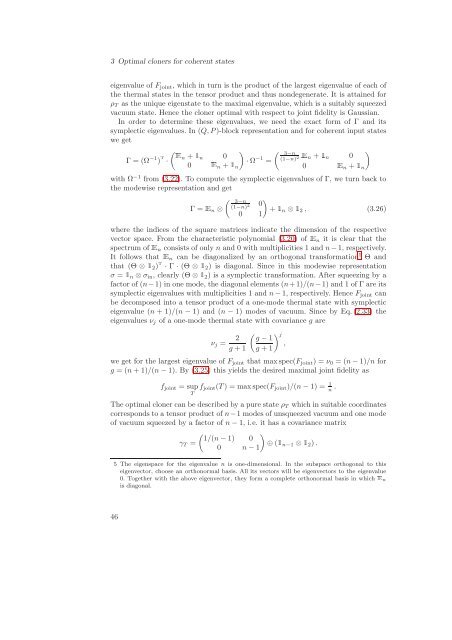Quantum Information Theory with Gaussian Systems
Quantum Information Theory with Gaussian Systems
Quantum Information Theory with Gaussian Systems
You also want an ePaper? Increase the reach of your titles
YUMPU automatically turns print PDFs into web optimized ePapers that Google loves.
3 Optimal cloners for coherent states<br />
eigenvalue of Fjoint, which in turn is the product of the largest eigenvalue of each of<br />
the thermal states in the tensor product and thus nondegenerate. It is attained for<br />
ρT as the unique eigenstate to the maximal eigenvalue, which is a suitably squeezed<br />
vacuum state. Hence the cloner optimal <strong>with</strong> respect to joint fidelity is <strong>Gaussian</strong>.<br />
In order to determine these eigenvalues, we need the exact form of Γ and its<br />
symplectic eigenvalues. In (Q, P)-block representation and for coherent input states<br />
we get<br />
Γ = (Ω −1 ) T<br />
n<br />
<br />
+ n 0<br />
·<br />
· Ω −1 3−n<br />
= (1−n) 2n<br />
<br />
+ n 0<br />
0 n + n<br />
0 n + n<br />
<strong>with</strong> Ω−1 from (3.22). To compute the symplectic eigenvalues of Γ, we turn back to<br />
the modewise representation and get<br />
3−n<br />
Γ =n ⊗ (1−n) 2 <br />
0<br />
+ n ⊗ 2 , (3.26)<br />
0 1<br />
where the indices of the square matrices indicate the dimension of the respective<br />
vector space. From the characteristic polynomial (3.20) ofn it is clear that the<br />
spectrum ofn consists of only n and 0 <strong>with</strong> multiplicities 1 and n −1, respectively.<br />
It follows thatn can be diagonalized by an orthogonal transformation 5 Θ and<br />
that (Θ ⊗ 2) T · Γ · (Θ ⊗ 2) is diagonal. Since in this modewise representation<br />
σ = n ⊗ σin, clearly (Θ ⊗ 2) is a symplectic transformation. After squeezing by a<br />
factor of (n−1) in one mode, the diagonal elements (n+1)/(n−1) and 1 of Γ are its<br />
symplectic eigenvalues <strong>with</strong> multiplicities 1 and n − 1, respectively. Hence Fjoint can<br />
be decomposed into a tensor product of a one-mode thermal state <strong>with</strong> symplectic<br />
eigenvalue (n + 1)/(n − 1) and (n − 1) modes of vacuum. Since by Eq.(2.33) the<br />
eigenvalues νj of a one-mode thermal state <strong>with</strong> covariance g are<br />
νj = 2<br />
g + 1<br />
j g − 1<br />
,<br />
g + 1<br />
we get for the largest eigenvalue of Fjoint that maxspec(Fjoint) = ν0 = (n − 1)/n for<br />
g = (n + 1)/(n − 1). By (3.25) this yields the desired maximal joint fidelity as<br />
fjoint = sup fjoint(T) = max spec(Fjoint)/(n − 1) =<br />
T<br />
1<br />
n .<br />
The optimal cloner can be described by a pure state ρT which in suitable coordinates<br />
corresponds to a tensor product of n−1 modes of unsqueezed vacuum and one mode<br />
of vacuum squeezed by a factor of n − 1, i.e. it has a covariance matrix<br />
<br />
1/(n − 1) 0<br />
γT =<br />
⊕ ( n−1 ⊗<br />
0 n − 1<br />
2).<br />
5 The eigenspace for the eigenvalue n is one-dimensional. In the subspace orthogonal to this<br />
eigenvector, choose an orthonormal basis. All its vectors will be eigenvectors to the eigenvalue<br />
0. Together <strong>with</strong> the above eigenvector, they form a complete orthonormal basis in whichn<br />
is diagonal.<br />
46
















